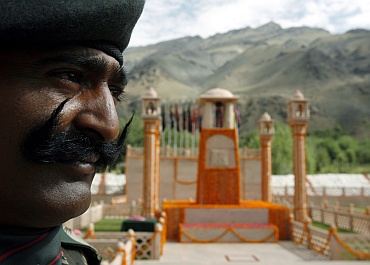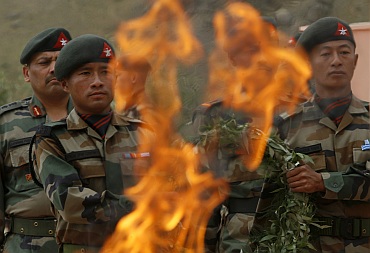Photographs: Fayaz Kabli/Reuters Azhar Qadri in Drass
Every day dozens of vehicles carrying tourists make a stopover at Drass War Memorial, a grim reminder to what happened in this region in the last year of the previous millennium.
For centuries, temperatures in winters plunge to the extreme minus 40 degrees Celsius. In the summer of 1999, this haunting insignia for the remote and sparsely populated Drass town, changed forever.
Despite the desolation of this town, with barren and unending mountain peaks, Drass is the new name emerging in conflict tourism in recent years.
Drass memorial: Invoking memories of Kargil war
Image: A woman walks near the illuminated war memorial during Vijay Diwas in DrassPhotographs: Danish Ismail/Reuters
Each day, families come to this memorial to know about what happened during the war, take pictures, write their comments and re-embark on their journey. Soldiers become guides providing information about the events of the war.
The memorial, on NH-1D, includes a huge epitaph with names of all the officers and soldiers who died in the 1999 war.
"This war memorial brings back the memories of the sacrifices of our officers and soldiers during the war. If someone travels by road, he is reminded that this is the place where young men sacrificed their lives in line of duty," Colonel Deepak Verma, commanding officer of 298 Field Regiment, said.
Drass memorial: Invoking memories of Kargil war
Image: A part of the epitaph with names of all the officers and soldiers who died in the 1999 warIn May 1999, the army mobilised its infantry battalions, which were engaged in counter-insurgency operations in Kashmir Valley, and its heavy artillery, including Bofors guns and moved them 150 km from Srinagar through potholed dusty roads which snake through hundreds of Himalayan mountains.
It was the war for Kargil, to save Ladakh from being cut-off from the Kashmir division as Pakistani forces, which included officers and soldiers from its Northern Light Infantry, commandos from Special Services Group and militants from a spectrum of groups, had barricaded themselves in the fortified bunkers in the upper mountain reaches on this side of the Line of Control.
Drass memorial: Invoking memories of Kargil war
Image: Army soldiers take part in a wreath laying ceremony at the war memorial during Vijay Diwascelebration in DrassPhotographs: Danish Ismail/Reuters
Hawaldar Sukhwinder Singh from 14 Sikh battalion is the briefing non commissioned officer assigned with the task of attending tourists and providing them information. "A lot of people come here every day, they pay their tributes to the officers and soldiers of Kargil war," Singh said, adding, a diary maintained at the memorial shows visitors from all corners of the country coming there.
The Manoj Padey War Gallery at the memorial complex is a window into the past. Named after a captain of Gorkha Rifles who died in the war, it has pictures of soldiers marching on the mountain slopes, soldiers cooking food in the upper reaches during the war and weapons recovered from the Pakistani forces.
Drass memorial: Invoking memories of Kargil war
Image: Army soldiers perform during a wreath laying ceremony at the war memorial during Vijay Diwas in DrassPhotographs: Danish Ismail/Reuters
There is also a picture of a Pakistani soldier being arrested from a mountain redoubt and another of Captain Vikram Batra, who became a poster boy of the war, with a captured Pakistani heavy machine gun.
Then there is a picture of a dead Pakistani officer -- Captain Karnal Sher Khan from Northern Light Infantry -- whose valour impressed the Indian Army so much so that it asked its Pakistani counterpart to honour him with Nishan-e-Haider, the highest military award in Pakistan.
Khan was later felicitated posthumously. At the gallery, there are also remnants of the
mortar shells fired by Pakistani forces on Indian positions and convoys.
Drass memorial: Invoking memories of Kargil war
Image: A senior Army officer places a torch at a war memorial during Vijay Diwas celebration in DrassPhotographs: Fayaz Kabli/Reuters
Gopal Krishnan, a retired man from Bangalore, who was on his way to Leh to spend holidays with his family, listens patiently as an army major briefs him at the gallery.
"My son called me and asked me to visit this memorial. He had seen it on TV that some function was being held here," said Krishnan, who was accompanied by his wife Savitri and sister-in-law Meena.
The major is a veteran of the war having fought in the Batalik sub-sector. "We had read about this war in newspapers and watched it on TV, but here when you hear from those men who experienced the whole thing, it seems so real, it's so tragic," said Meena, a visitor from Mumbai.






article